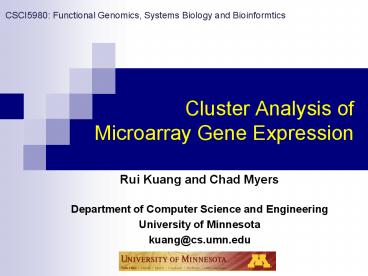Cluster Analysis of Microarray Gene Expression - PowerPoint PPT Presentation
1 / 22
Title:
Cluster Analysis of Microarray Gene Expression
Description:
Department of Computer Science and Engineering. University of Minnesota. kuang_at_cs.umn.edu ... Measurements of 6,220 ORFs at 15 time points ... – PowerPoint PPT presentation
Number of Views:175
Avg rating:3.0/5.0
Title: Cluster Analysis of Microarray Gene Expression
1
Cluster Analysis of Microarray Gene Expression
CSCI5980 Functional Genomics, Systems Biology
and Bioinformtics
- Rui Kuang and Chad Myers
- Department of Computer Science and Engineering
- University of Minnesota
- kuang_at_cs.umn.edu
2
Hierarchical Clustering
- Organize the genes in a structure of a
hierarchical tree - Initial step each gene is regarded as a cluster
with one item - Find the 2 most similar clusters and merge them
into a common node - The length of the branch is proportional to the
distance - Iterate on merging nodes until all genes are
contained in one cluster- the root of the tree.
3
K-MEANS
- The user sets the number of clusters- k
- Initialization each gene is randomly assigned to
one of the k clusters - Average expression vector is calculated for each
cluster (clusters profile) - Iterate over the genes
- For each gene- compute its similarity to the
cluster profiles. - Move the gene to the cluster it is most similar
to. - Recalculated cluster profiles.
- Stop criteria further shuffling of genes results
in minor improvement in the clustering score
4
How Many Clusters?
- Try several parameters and compare the clustering
solutions - Mathematical criteria for comparison of
clustering solutions later in the presentation - PCA (Principle Component Analysis)
- A technique for projecting the gene expression
data set onto a reduced (2 or 3 dimensional)
easily visualized space
5
PCA - Example
- Dataset Thousands of genes probed in 5
conditions (time points relative to treatment) - The expression profile of each gene is presented
by the vector of its expression levels X (X1,
X2, X3, X4, X5) - Imagine each gene X as a point in a 5-dimentional
space. - Each direction/axis corresponds to a specific
condition - Genes with similar profiles are close to each
other in this space - PCA- Project this dataset to 2 dimensions,
preserving as much information as possible
6
PCA Example
Visual estimation of the number of clusters in
the data
7
K-MEANS example 4 clusters
8
Cluster 1
Cluster 3
Mis-classified
Cluster 4
Cluster 2
9
K-means example 3 clusters
10
Too few clusters K2
11
Convergence of K-MEANS
- Define goodness measure of cluster k as sum of
squared distances from cluster centroid. - Reassignment monotonically decreases G, since
each vector is assigned to the closest centroid. - Stop criteria, e.g.,
- A fixed number of iterations.
- Gene partition unchanged.
- Centroid positions dont change.
12
Time Complexity
- Computing distance between two genes is O(m),
where m is the number of experiments. - Reassigning clusters O(Kn) distance
computations, or O(Knm). - Computing centroids Each doc gets added once to
some centroid O(nm). - Assume these two steps are each done once for I
iterations O(IKnm).
13
K-MEANS Example
- Tavazoie et al., Nature 1999
- Cell cycles of S. cerevisiae
- Measurements of 6,220 ORFs at 15 time points
- K-means clustering discovers 30 clusters of 3,000
genes - Interpretation with MIPS protein functions and
common transcription factor binding motifs
14
K-MEANS Example
MluI cell-cycle box
Swi 4/6 cell-cycle box
15
K-means
- Advantages
- Simple and fast!
- Disadvantages
- The number of gene clusters is unknown
- No structure between the clusters
- Not robust to outliers centroid can be greatly
affected by outliers
16
SOMs (Self-Organizing Maps)
- User sets the number of clusters in a form of a
rectangular grid (e.g., 3x2) map nodes - Imagine genes as points in (M-dimensional) space
- Initialization map nodes (corresponding to
clusters) are randomly placed in the data space
17
Genes data points
Clusters map nodes
18
SOM - Scheme
- Randomly choose a data point (gene).
- Find its closest map node
- Move this map node towards the data point
- Move the neighbor map nodes towards this point,
but to lesser extent - Iterate over data points
19
- The extent of node displacements is relaxed with
the iteration number - After thousands of iterations
- Assign each gene to the map node (cluster) it is
most similar to
20
SOM Example
- Tamayo et al., PNAS 1999
- Cell cycles of S. cerevisiae dataset and human
hematopoietic differentiation.
21
SOM Example
- Two Cell cycles of S. cerevisiae
- 6 X 5 SOM
22
How to evaluate clustering solution
- S and T are two clustering solution.
- n11 of pairs that are mates in both S and T
- n10 of pairs that are mates only in S
- n01 of pairs that are mates only in T
- Jaccard coefficient correctly identified mates
vs all mates in S and T - Minkowski coefficient disagreements vs true
mates in S































